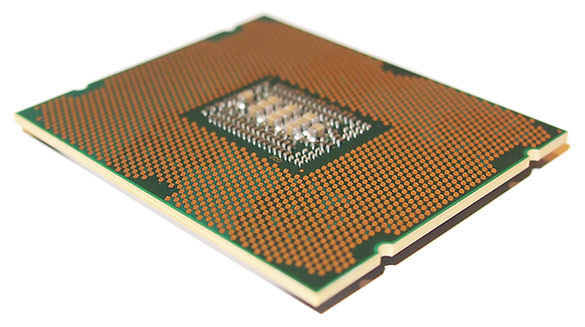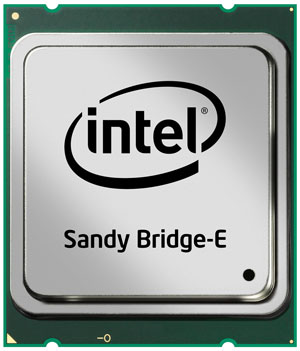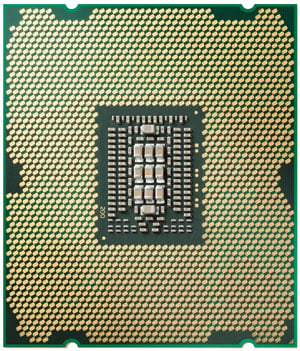Intel Core i7-3970X Sandy Bridge-E CPU Review
Introduction and Specifications
It’s no secret that Intel is readying processors based in its Haswell microarchitecture. The new chips are due to be released in the not too distant future and feature a number of noteworthy enhancements, including a much more powerful integrated graphics core. When Haswell arrives though, it will supplant current Ivy Bridge-based processors, which target more mainstream market segments than the product we’ll be showing you today. For the foreseeable future, Intel’s big dog remains Sandy Bridge-E, the monstrous six-core beast which utilizes the X79 Express chipset and socket LGA 2011.
Prior to the arrival of Haswell, we figured it would be a good idea to show you just what Intel’s current flagship desktop processor can do. That processor is the Core i7-3970X, pictured below. Last year, when Intel originally released Sandy Bridge-E, we covered the Core i7-3960X and discussed the X79 Express chipset and associated motherboards and related components. If you want a refresher on what Sandy Bridge-E is all about, we suggest taking a look at that article. We’ll detail the main features and specifications of the Core i7-3970x below, but we won’t be re-posting all of the technical details already mentioned in the launch piece.

Intel's Core i7-3970X Extreme Edition Processor
|
|
Six Core Processing: Runs 6 independent processor cores in one physical package Base Processor Frequency: 3.50 GHz Massive PCI Express Bandwidth: 40 lanes of PCIe supported through the processor Intel Turbo Boost Technology: Dynamically increases the processor frequency up to 4.0GHz when applications demand more performance. Speed when you need it, energy efficiency when you don’t. Intel Hyper-Threading Technology: 12 threads provide unprecedented processing capability for better multi-tasking and threaded applications. Do more with less wait time. Intel Smart Cache: Up to 15MB of shared cached allows faster access to your data by enabling dynamic and efficient allocation of the cache to match the needs of each core significantly reducing latency to frequently used data and improving performance. Overclocking Enabled: Core (Turbo) and DDR3 ratios are unlocked for ease of overclocking Integrated Memory Controller: Supports 4 channels of DDR3-1600 memory with 1 DIMM per channel. Support for XMP memory. See this site for certified XMP memory. |


Intel LGA 2011Sandy Bridge-E Processor, Top and Bottom
Sandy Bridge-E based processors are manufactured using Intel’s advanced 32nm process node and feature roughly 2.27 billion transistors. The die size is approximately 434.7mm2 (20.8 mm x 20.9 mm). The processors feature up to 6 active execution cores that can each process two threads simultaneously courtesy of Intel’s HyperThreading technology, for support of a total of 12 threads. We should point out, however, that SBE actually has eight cores on-die, but due to power and yield constraints, only six are active at this time. The actual cores are essentially identical to the original Sandy Bridge microarchitecture and support the same Intel AVX and AES instructions, along with SSE4.1, SSE4.2, etc.
As we mentioned, the Core i7-3970X Extreme Edition is designed for Intel’s socket LGA 2011, and it requires a compatible motherboard built around the new X79 Express chipset. The processor sports 15MB of shared L3 Intel Smart Cache, although there is actually 20MB on die (the remaining L3 is disabled along with those other two cores), and feature an integrated quad-channel memory controller with official support for DDR3 memory at speeds up to 1600MHz, although higher speeds are possible through overclocking. Sandy Bridge-E based processors like the Core i7-3970X also feature 40 integrated lanes of PCI Express connectivity, that support speeds equivalent to the 8GT/s PCI Express 3.0 specification.
The Intel Core i7-3970X Extreme Edition processor has a base clock frequency of 3.5GHz with a maximum Turbo frequency of 4.0GHz. It achieves those clocks using a BCLK of 100MHz and multipliers ranging from 35 to 40, although lower and higher multipliers are available with this unlocked processor. The chip sports 192K of L1 data cache (32K per core), 192K of L1 instruction cache (32K per core), and 1.5MB of L2 cache (256K per core). The Core i7-3970X Extreme Edition is also outfitted with 15MB of shared L3 cache. The 3970X has a 130W TDP and requires a .6v to 1.35v input voltage, that will dynamically scale as lower or higher multipliers are used, like when Turbo Boost frequencies kick in, for example.






